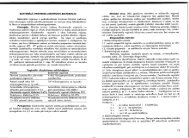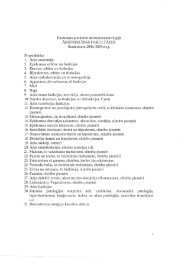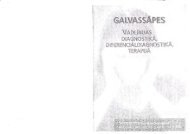PHYSICS
n - susliks.lv
n - susliks.lv
- No tags were found...
You also want an ePaper? Increase the reach of your titles
YUMPU automatically turns print PDFs into web optimized ePapers that Google loves.
echo intensity, the animal can determine whether it is approaching<br />
or receding from the object.<br />
Example. If a bat detects an echo from an insect, it increases the<br />
frequency of pulses to as high as 100 pulses per second. What is the batobject<br />
distance?<br />
Soultion. The distance (D) between the bat and insect is given by:<br />
D = Vt/2 = (340 m/s)·(l/lOO s)/2 = 1.7 m.<br />
The third mechanism is based on the frequency change of the<br />
echo which is called the Doppler effect.<br />
72<br />
8.3. THE DOPPLER EFFECT<br />
There is a well known train-spotter's observation that the pitch<br />
of a train's whistle changes as it passes the observer. As the train<br />
approaches, the observer hears a note which is higher than the<br />
true note and on passing, the pitch quickly falls to a lower note<br />
than the true pitch. C. I. Doppler in 1842 was the first to give an<br />
explanation for the phenomenon which has been entitled the<br />
Doppler effect. In the example above, if the frequency of the<br />
whistle is f o when the train is stationary, then the frequency (f)<br />
as detected by an observer alongside the track, differs from f o in<br />
relation to the speed (V) of the train. The fractional change in<br />
the apparent frequency of the whistle (i.e. if - fo)/f o) is related to<br />
the velocity of the train by the formula:<br />
if - fo)lf o = ±VI V, (8.1)<br />
Here V s is the speed of sound. A "+" sign indicates the train is<br />
approaching the observer and a "-" sign indicates the train is<br />
moving away from the trackside observer.<br />
When either the source or the receiver of a propagating wave<br />
moves, there is usually a change in frequency called the Doppler<br />
shift. Such a shift can be used to determine the velocity of the<br />
target along the line to it, which is to say its approach velocity. If<br />
the transmitter generates a frequency of f o ' the velocity of the<br />
sound is ~, and the approach velocity is a much smaller value<br />
(V), the received frequency is approximated by:<br />
1 = 10 (I + 2V a )<br />
V s<br />
(8.2)<br />
The frequency shift is proportional to the approach velocity:<br />
Af =1 - 10 to Va<br />
s<br />
(8.3)<br />
Example. What is the Doppler frequency shift received by a bat, if the<br />
insect is immobile with respect to the bat's motion with the velocity<br />
equal to 5 m/s. The frequency of the bat's sound is 60 kHz.<br />
Solution. We can insert the values into the Doppler shift equation (8.3):<br />
fj.f = 2 fo Va 2·60 ·10 3 Hz 5 m/s = 1. 76 kHz<br />
V, 340 m/s<br />
The Doppler effect enables one to measure the translational,<br />
rotational speed, and the frequency of flagellum beatings of microorganisms.<br />
The Doppler shift of sound waves scattered by moving<br />
erythrocytes (red blood cells) is used to measure the speed<br />
of blood flow; also the Doppler shift of light waves scattered by<br />
moving blood in the retina can be used to study blood flow there.<br />
,r/<br />
~~ . .If'.<br />
1"'4 ~<br />
"I love hearing that lonesome wail<br />
ofthe train whistle as the magnitude<br />
ofthe frequency ofthe wave changes<br />
due to the Doppler effect. "<br />
(From R.A. Serway, 1992)<br />
Chapter 9. ACOUSTOBIOLOGY<br />
Acoustobiology is the branch of biophysics which studies of<br />
how living organisms hear sounds, and how sounds affect them<br />
physically and behaviorally.<br />
9.1. ACOUSTORECEPTION<br />
Mammals. The ear is one of the most remarkable devices<br />
known to science. This section considers several of the properties<br />
and mechanisms of the ear. The ear is divided into three parts<br />
designated simply as outer, middle and inner ear (fig. 9.1).<br />
73






